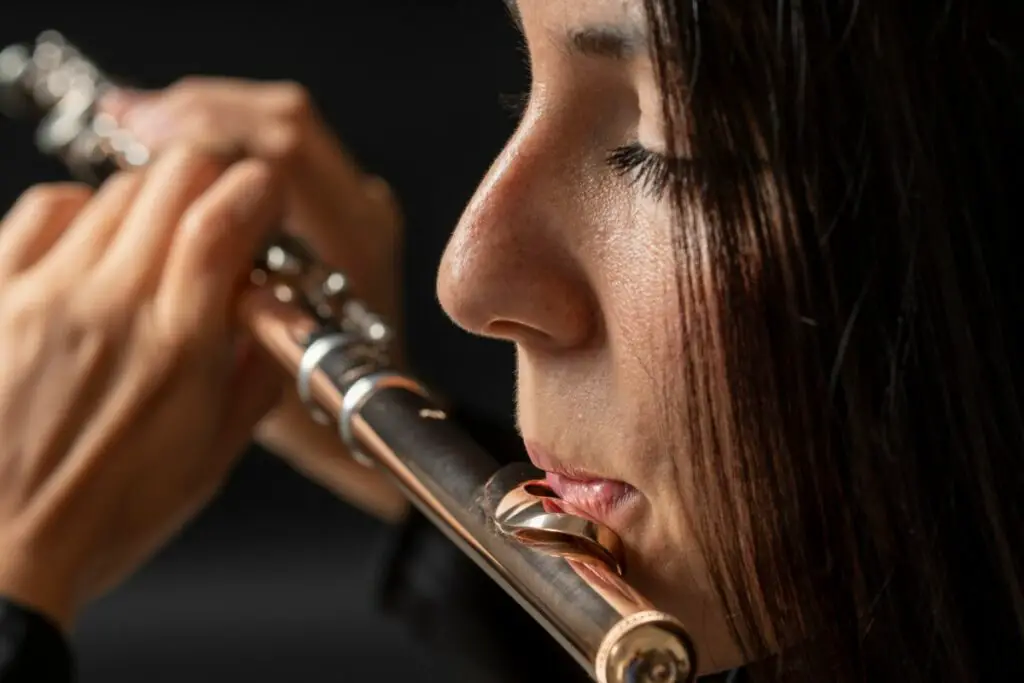What is the Highest Note on a Flute?

The flute is an instrument in many marching band and orchestra settings. They are part of the woodwind family known for sounding beautiful, especially in the higher octaves. With its incredible range, higher notes can be particularly challenging. But what is the highest note on a flute?
The highest note on a standard flute is the C note. This note is the 4th octave C (or C7), 3 octaves above middle C.
There are certain skills a flutist must master to play this high note. The highest note that can be played also changes according to the type of flute that is being used.
How Hard is it to Play the Highest Note?
The official highest note that can be attained on a standard flute is the C note or the 4th octave C. This is the highest note the instrument is designed for.
It’s extremely hard for a flutist to play this note, especially when holding it for long periods. For non-professional flutists, it’s challenging to hit a note higher than a 4th octave C. Being able to play this high is the mark of a very talented flutist.
Reaching the highest note possible requires embouchure skills and strict breathing control. Professional flutists practice for years to hit extremely high notes.
Six Tips on How To Play the Highest Note on a Flute
Here are some tips for playing the highest note possible on the flute. We hope these practices help you play the 4th octave C successfully.
1. Air Regulation
Flutists have to time their breaths carefully to ensure they have enough air to manipulate the pressure and direction of air successfully. If you don’t have enough air in your lungs, you won’t have enough support to make high notes sound good when played. Forcing the sound with too large of a breath will result in an unfocused sound and will most likely make you lightheaded.
2. Fast and High Air Pressure
With proper air regulation, you can control how much pressure is applied to the embouchure hole. The air pressure refers to the speed and force of the air flowing within the instrument. Playing a 4th octave C requires fast air speed and pressure. Creating a forceful air stream may cause exhaustion in young players, which is why practice is essential.
3. Small Aperture
To ensure the highest note is played with clarity, you must produce a smaller aperture. Aperture refers to the size and shape of the hole between your lips when blowing air into the instrument. The smaller the hole in our lips, the less space the air has to travel through, increasing the air pressure.
4. Air Direction
To play a 4th octave C, blow the air across the embouchure hole in a slightly upward direction rather than parallel. Extending your jaw and lower lip will help you force the air upward.
5. Finger Control
You need to quickly move your fingers to new positions, but most amateur flutists struggle with operating the upper register of the flute because of its position. You must be able to operate the upper register of your flute to play a 4th octave C. A smooth transition between the high C and the surrounding notes is necessary for a clean sound. Practicing finger transitions at a slower speed and slowly increasing your speed as you gain control will allow you to eventually play the upper register successfully.
6. Give Yourself Some Grace
If you are still new to the flute, you won’t be able to play the highest note overnight. It takes a lot of practice, so give yourself time to get it right. Stay consistent, schedule regular practices, and set up some time whenever you can play.
Is The Highest Note on The Flute Played Often?

The highest note and all other high flute notes are more common in orchestras, as many songs here have high flute notes in the composition. Even in these settings, C7 isn’t often used because it’s impractical. Higher notes are loud, piercing, and not pleasing to the ear when in constant use.
It’s relatively easy to hear high flute notes while other, louder instruments are being played. Because an orchestra set is large and dense, the composer must make sure the flutes are positioned in an area where the sound can reach the audience effectively.
Outside of professional orchestra compositions, you will seldom hear a high C. However, in a professional orchestra, entire songs are often played in the upper register for the flute. Notes above the 4th octave C are rarely in compositions because of how hard these notes are to play.
You likely won’t hear flutist students play notes in the upper register, as teachers typically teach upper register skills last.
Overall, the 4th octave C isn’t common outside of orchestra settings because it is difficult for non-professional flutists to play the note with clarity.
Flute Types and Their Highest Note
There are multiple types of flutes, and each one has a different range. The traditional flute’s highest note is the 4th octave C, but some flutes can play higher notes because they have different structures and designs.
Here are some different types of flutes and their respective ranges:
- Soprano Flute: C4 (middle C) to C7 (three octaves above middle C).
- Bass Flute: C3 (one octave below middle C) to C6 (two octaves above middle C).
- Piccolo Flute: D5 to C8 (four octaves above middle C).
- Alto Flute: Pitched in the key of G from G3 to G6.
- Contrabass Flute: C2 (two octaves below middle C) to C5 (one octave above middle C).
- Subcontrabass Flute: C1 (three octaves below middle C) to C4 (middle C).
Overall, the highest note that you can play on a flute varies depending on the type of flute that you have and your skill level. If you want to play high flute notes, practice regularly and test your skills over time.








